#Magnetic Materials Market Size
Explore tagged Tumblr posts
Text
Key Drivers of the Global Magnetic Materials Market| MarketsandMarkets™
Magnetic materials are those that can be magnetized and thus attract other magnetic objects. These materials are composed of atoms with an unpaired electron, allowing them to align with an external magnetic field and generate a magnetic moment. Magnetic materials have a wide range of applications, from motors and generators to storage devices like hard discs and tapes. They’re also used in…

View On WordPress
#ceramic magnet#ferromagnetic material#Global Magnetic Materials Market#Magnetic Materials#Magnetic Materials Demand#Magnetic Materials Industry#Magnetic Materials Manufacturers#Magnetic Materials Market#Magnetic Materials Market Forecast#Magnetic Materials Market Growth#Magnetic Materials Market Share#Magnetic Materials Market Size#Magnetic Materials Price#magnetic particle testing#soft magnetic materials market
0 notes
Text
#soft magnetic materials#soft magnetic materials market#soft magnet materials market size#soft magnet materials market share
0 notes
Text
Voya-Nui: An Overview

Hello,
This will be somewhat similar to my 1/10th scale Mata Nui posts, discussing the floating island of Voya-Nui based upon recently revealed information, mainly dealing with its size and role in the initial story.

Warning, this post is embarrassingly long.
Any who have the misfortune of knowing me know I have a rather selective view of what constitutes Bionicle. Essentially I consider Bionicle to have run from 1998 to mid 2002. As a kid I was a die hard fan until 06, where a combination of the marketing and the sets just not being very good caused me to gradually lose interest until I just got one set in 07 and never again bought a Bionicle.
All this preamble is to say that for the longest time I never really knew all that much about Voya-Nui, apart from it being the namesake of a terrible game. Later on, as I got back in to the hobby I heard rumors, dark, twisted rumors. They spoke of a stick making the island fly underwater through a hole, that the island itself was ejected from the body of the robot and left a Voya-Nui sized hole in a continent. Just the ravings of a mad man, so I threw it in the bin along with everything in Bionicle after the Toa go in to the Bohrok hives in 02 and moved on with my life.
Fast forward to now, and Christian Faber starts releasing some development materials through a humanoid water fowl, and this very interesting image is among what's released
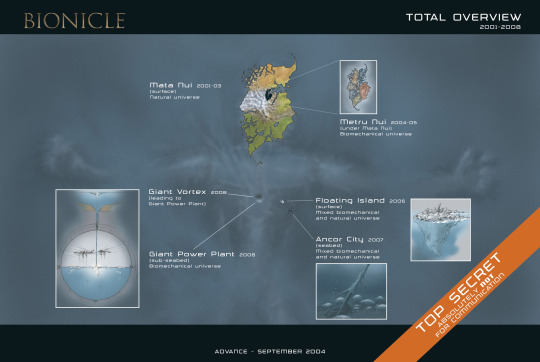
This image made everything click for me and I fell in love with Voya-Nui as a concept.
But I think before revealing the original intent, its important to explain the "canon" sequence of events surrounding the so called "Island of Doom"
ISLAND OF DOOM, A PRIMER
Okay so there's a big robot sleeping in an ocean, one day its heart pops and a chunk of land that was on top of the heart breaks out of its chest and starts floating in the ocean. The island, I must add, survived this event, as the hole it left is the same shape and size as the final island.
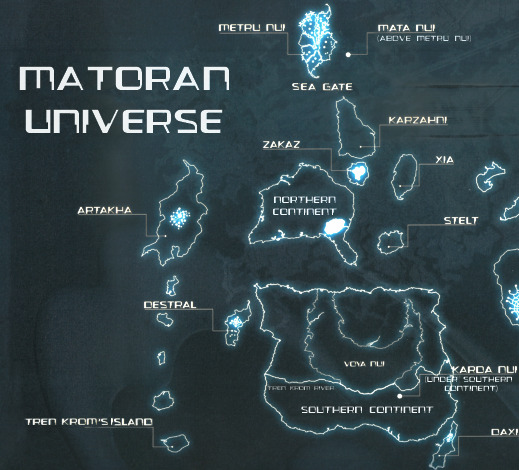
Now the island floats around for a bit, the volcanic crater on it eventually builds up a large land mass in the middle of the bay, the people on it (yes there were people on the island when it got ejected, and they survived the event) decide that this is the best place to build a city.
It turns out that wasn't the best place to build a city as the new land mass breaks off and somehow anchors it to the sea floor.
Eventually some guys show up and break the anchor cord and the island, inexplicably, sinks down under the water, and manages to go right back in to the hole it made and everything returns to normal.

In some blog post it was explained that there was a magic wand that fixed everything that was used at the same moment.
This is the canonical sequence of events.
More like island of dumb¹.
THE ORIGINAL CONCEPTS
Okay now that all that unpleasantness is out of the way, we can start with the actually interesting things.
There are so many details to cover here, I think the best way to organise them would be to present everything roughly chronologically.
The scenario is the same, a massive robot crash lands in a large ocean, its completely under the water outside of its face, upon which the larger island of Mata Nui forms.
From the beginning its very different, there's no large landmass over the heart (in fact the very idea of the robot itself being full of various domes with islands in them is very suspect but this post is already long enough). The heart is a reactor, and consists of a massive spherical cavity in the chest. Something occurs and the heart pops open, a small panel or valve on the perimeter of the reactor core's wall bursts out of the chest of the robot. Through this hole sea water begins to flood in-this is important!

The ejected panel floats, and some sort of system within it cools it down, causing the sea water to freeze, essentially turning it in to a massive iceberg. There's also mentions of it being magnetic, the final island is described as looking somewhat like a magnet run over a factory floor. It probably also attracted debris from the sea bed as it floated through the seas. As you can see in that diagram the core is filled with massive long cables and the island eventually gets anchored by a long cable, so that's possibly where that came from!

Over years the island grows and grows as it floats around the oceans, being buffeted around by the currents. Eventually part of it becomes unstable and breaks off, sinking to the ocean floor, and since a large cable was attached to both pieces, it anchors the island in place.
Now we get to the crucial part. In the canon depiction of events the most baffling thing is why does breaking the anchor rope make it sink? Now we come back to this image:

When the panel popped out it left a hole. Water is pouring back in to the hole, forming a giant whirlpool. The robot is so massive that even after all these years of constant flooding the cavity on the inside is still not even half full. Voya-Nui was caught in the whirlpool's strong currents when the island broke up. This impromptu anchor stopped it just as it was about be pulled in! Then the super strong currents from the whirlpool gave it the distinctive curved shape.
So now we know why destroying the cable holding it in place causes the floating island to sink: once untethered its free to be pulled in to the whirlpool! The island that formed around the panel would break off and the panel would basically be a giant plug and stop the flow of water flooding in to the reactor.
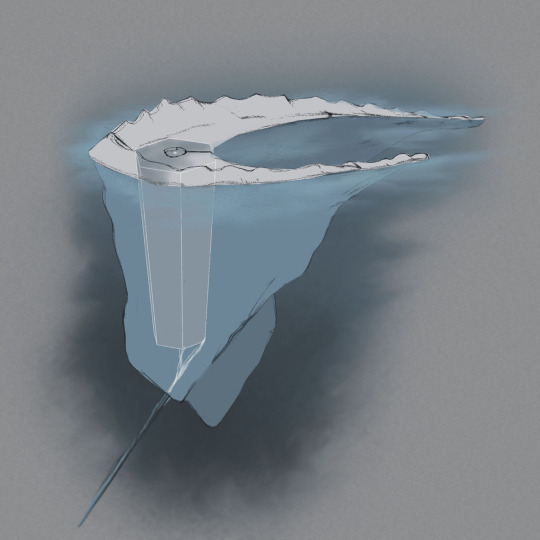
Figuring this all out was such a revelation, taking one of the most nonsensical sequences of events in the series and transforming it in to this completely logical scenario which, from the point of view of the characters involved, is still quite mysterious and oblique, but when looked at from the perspective of repairing this giant robot it makes perfect sense.
And we were robbed. Imagine the Mata Nui rising sequence of animations starting off with a whole island being pulled in to a whirlpool.
THE CORE
This is getting a bit beyond the main focus of the island, but I just want to talk about the core itself because there were a few interesting tidbits there as well. Its a very evocative setting which I feel suffered greatly and few of the interesting parts were conveyed well in the story.
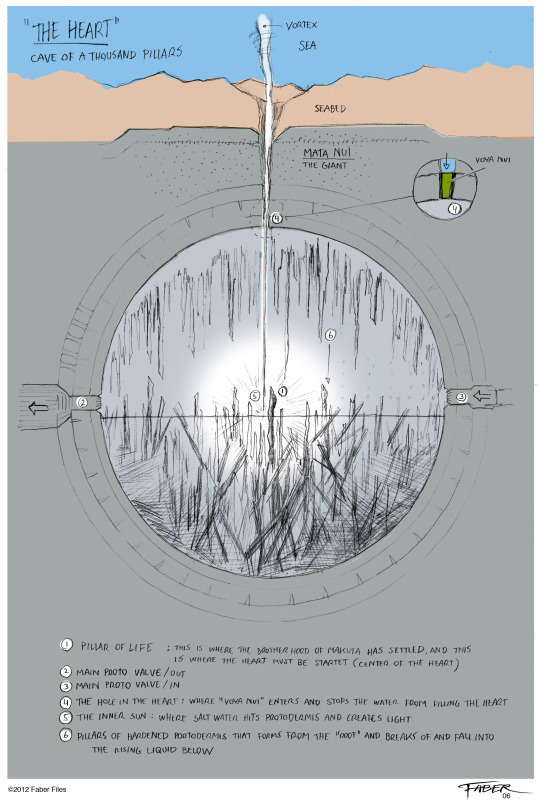
The water streaming through the hole is described as having some sort of light emitting reaction to the part of the reactor its hitting, lighting the whole chamber. Steam from the reaction swirls upwards and vaporised materials from the heat of the reaction collect on the roof, forming massive stalactites that eventually fall, creating this jagged forest of stone needles within the massive pool of water, water which's temperature varies depending on how close it is to the reaction.

Really seems a shame that in the final story it was simplified down to "sky" and "swamp". Just imagine, this forest of stone, shrouded in fog, lit by this flickering unearthly light emanating from the centre. You have the added aspect of once Voya-Nui has returned to its rightful place the water fall would cease, leading to the light dwindling until the whole area is pitch black.
MISCELLANEOUS OTHER NOTES

One major feature of the island that was missing from the earlier ice and rock version is the massive lava crater, supposedly from the mask of life². I had been toying with the idea that the volcano formed the rest of the island around the panel, but with how much larger the island was it just didn't make sense, so the ice and magnetism really helped out there!
Its said that the ice formed as some sort of self defence mechanism, like an organ freezing itself to preserve itself in an emergency. Personally though I have this little idea that the panel was actually something like the cooling system for the reactor, and without it the reactor was going to over heat, but luckily it was kept just cool enough by the falling water. The cooling system, being linked somehow to the main robot, detects that the reactor was over heating and starts working over time to cool it, leading to it freezing the surrounding ocean and making itself in to a massive iceberg, but as it wasn't connected to the robot's core and nothing it did had any effect, it ends up overheating itself, causing the pool of lava on the top. But that's just a little fan idea.
Another one I have is that the island, when it was floating freely, may have passed next to Mata Nui, close enough to be sailed too, at some point far in the past. Explaining how there would be inhabitants on it despite it getting shot out of the robot like a bullet.
Also it would be remiss of me to not mention that even though the canon depiction of events makes no sense, the whirlpool is briefly seen in the 100% ending of the torture device Bionicle Heroes.

But this is much smaller, and seems to only have just opened up in the bay. Rather than being something to do with the hole it made it seems this is more about how the mask they were seeking went underwater.
SCALE!
Time to talk sizes!³

This drawing is especially useful here, as it shows all 3 major objects in question all relative to each other. Yes Voya-Nui is there, its the tiny little dot on the bottom right. So I simply took the height maps for Voya-Nui, used them to make a quick little model in the same fashion as my Mata Nui, and brought in my old GSR model. I scaled them all to the Mata Nui from my last posts, and guess what! It all lines up perfectly.

The Voya-Nui Model is the exact right size it should be, according to this map:

And what was more impressive, was that the GSR turned out to be pretty much bang on with this even older concept art:

Scaling the GSR was a more bit awkward, as the final design is more gangly compared to this drawing, but lining up the torsos worked really well!

And now let us visit the 1/10th scale Mata Nui and meet Geroge. A new island has floated up off Ta-Wahi beach and he want's to explore a bit!

Excuse the monochrome island, the height maps I'm using are actually quite different from the final island.


There is a height map more accurate to the final island, but that one didn't have an underside. The little islets in the bay were also neat.

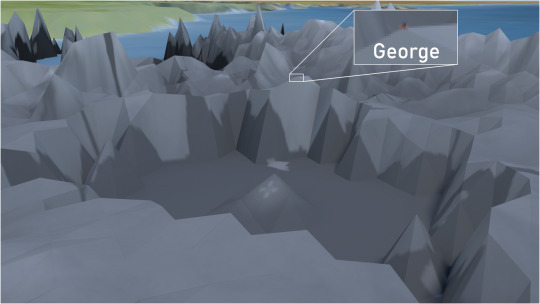
The large lava lake in the centre is roughly 250 metres across. Its nothing compared to Mata Nui's caldera, but its still very huge when you get down to the ground level.
The panel that forms the centre of the island is massive as well.

Approximately 550m wide, and 900m tall. Just think of the massive reactor core this thing popped out of!

Seeing it separate from the island really puts it in perspective.
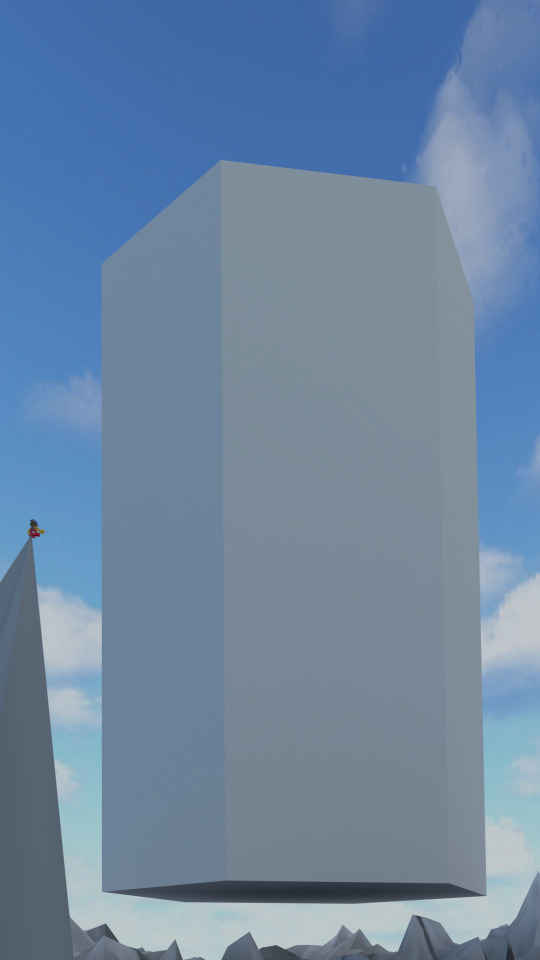
Imagine this thing shooting out of the robot's chest like a bullet.
I'll just quickly mention, earlier on I posted that map of all the internal islands. If you use the size of metru nui on there you can scale Voya-Nui appropriately, and you end up with this.

Its less a small panel popping out of the heart and more the scene from Alien at this point.
CONCLUSION
This has been quite a rambly post, but there was just so much information to cover. I left out a lot of details. This whole thing just makes me very excited, sorry.
I just think its such a beautifully elegant scenario that really adds a lot to the setting and story, rather than just having yet another new island, but this time the island is mean. I find it quite interesting how everything would have sorted itself out, if not for the island breaking in half. There's no Machiavellian plots, no scheming, no betrayal, just an unfortunate occurrence that makes a bad situation worse, and everyone has to work to fix it. It was utterly butchered in the final story. It makes me quite sad for what could have been. Just picture it, this floating island getting pulled towards a massive whirlpool, the outer island breaking off as it spirals deep down underwater until this long, tarnished metal plug is revealed to have been at the centre. With a huge impact it closes up the hole, fitting back perfectly where it came from, managing to avert the disaster of the flood waters growing ever higher inside the core of this robot.
But in any case, really the important take away is, Voya-Nui is just a rip off of Noah's Island when you get down to it.
I'll leave you with a photograph of George waving hello to his large friend.

Have a nice day/night[delete whichever is inappropriate]!
¹-You know its true. ²-Not to be confused with the Mask o' Flight, the film staring a swarm of Tahnok. ³-Please note, I am using 1 kio = .1 km as per my previous posts, if this offends you simply multiply every number in this post by 43.75966487787¾⁴ ⁴-Yes even this one.
While I was working on this I made some more revelations about the core which will probably need its own post. ;_; This thing already took 3 days to make....
#Bionicle#hypothesis#writeup#Mata Nui#Voya Nui#Great Spirit Robot#I managed to do this whole thing with only mentioning the characters of the story twice :)#quack
117 notes
·
View notes
Text



Price: 253.45$
Pockets: Three pockets One large main compartment, in the shape of a half-sphere. One tablet sleeve. One internal pocket for smaller items.
Material: 100% genuine cowhide full-grain top-layer leather, Handmade.
Size: 12.6"H, 12.6"L, 5.9"W. ~8.6 Liters
Colors: Red, Dark Brown, Black
Details: ● Personalization available: Add a monogram for an additional 10$ ● Interesting shape, reminiscent of an armadillo or pillbug. ● Unpadded straps, but due to the small capacity this is unlikely to cause many problems. ● Closes with a traditional buckle, not magnetized. ● The unpadded sleeve for a tablet should fit tablets under ten inches easily, exact dimensions are unknown. ● Marketed by the seller as unique, but this isn't exactly true. A handful of other sellers on Etsy also make this design.
#backpack#not amazon#etsy#2-5 pockets#novelty design#black#brown#red#<10 liters#personalization available#Leather#250-300$
6 notes
·
View notes
Text

Tomtoc Navigator-T61 Rolltop Backpack 20L Review
I Recently ordered a backpack after years of using shoulder bags. I still like my briefcase/shoulder bags for client meetings or office scenarios, but they’re just not convenient for travel or out in the field work. I didn’t need a backpack specifically for cameras because I use a Sony point/shoot camera and/or a small Sony camcorder, so no extra lenses or flashes are needed to be packed. But, I definitely need something that can protect my MacBook and other gear/necessaries.
That’s when I discovered @tomtocbags a relatively newer designer/manufacturer of laptop sleeves/bags/backpacks and gear cases. I really like the modern and sleek designs of their offerings. I also like their sustainability features: Manufactured with at least 50% recycled materials, manufactured at facilities that protects the rights and health of workers, and made with chemicals safer for people and the environment. They seem to be going for the market taken up by more expensive bag manufacturers like Timbuk2. Tomtoc was a refreshing and pleasant finding.

What I like about this backpack:
Modern, sleek, sustainable, and durable design.
Ample room for gear, clothes, and other necessities. Especially when rolled all the way up. Nice padded protective pockets for both a laptop and tablet, and slots for additional gear/tech.
Water resistant materials and waterproofed front pocket and back access zippers.
Expandable side pockets that can easily accommodate larger water bottles.
Quick access back zipper for laptop/tablet pockets, luggage strap on back, and a nice key hook/strap inside front side pocket.
Comfortable back padding and padded shoulder straps (no sternum strap, which I don't mind) with three carabiner loops on each side.
Price points that are much less than what companies like Timbuk2, Stubble&Co, and Wandrd are charging.


My wishlist for Tomtoc:
Side mount/compression straps to secure a longer umbrella, taller water bottle/thermos, and/or tripod would be nice. The backpack does have two top loops on both sides of bag that a carabiner paracord (see 1st above photo) or something like a Think Tank Photo Disguise Strap could be attached to.
I would have liked the inner lining to be orange, bright yellow, or lime green for visibility when searching for things inside.
I would have liked the bag to be a little larger at least aesthetically. I’m taller/larger (6’ 1” over 200lbs) so when not fully rolled up it looks a little small on me. Not an issue when the backpacks fully packed and rolled up (expands from 17 to 20L) though. However, I can see the size being a benefit when traveling by plane or when getting around in a city environment.
Though not that big of a deal, waterproofing the top and front side zippers like the front pocket and back access ones would be a smart move going forward.
Along with the carabiner loops, I wouldn't mind seeing a D ring on one of the shoulder straps in the future. But, nothing that a carabiner paracord (see 2nd above photo) wouldn't solve.
Final thoughts:
The Tomtoc 17-20L Navigator Roll Top Laptop Backpack definitely strikes a nice balance between great quality and affordability, making it one of the best minimalist roll top backpacks available at this price range. Not only is it constructed with durable materials, but the inside is ample enough for clothes and gear perfect for both short leisure and business trips, and also daily commutes and onsite work. Definitely recommend this backpack. Looking forward to checking out more of their products.

Update: I attached an 8Link Quick Release Magnetic Sternum Strap. Helps when I’m carrying more than usual and especially while traveling/away.

3 notes
·
View notes
Text
RS Security Co., Ltd is a modern enterprise with intelligent gate equipment and top quality services as its core. The company's main service is: construction site access control, face recognition Turnstile, Full height turnstile, acrylic swing turnstile, movable turnstiles, tripod turnstile, basketball court paid turnstile, car park barrier gate, totally automatic hydraulic bollard, and so on, with parking lot management Counting on the research and development, production, sales and service of devices, pedestrian gate management equipment, smart door openers and other items, we offer customers with thorough management services. For many years, the business has specialized in pedestrian tripod turnstile doors, swing barriers turnstilesturnstile, subway flap gates barrier, speedlane gates, gates, barrier-free systems, full body barrier door, access control, and parking lot systems, and has gradually enhanced the products of magnetic cards, IC/ID cards, barcodes, and infrared series products. Integrated application, through continuous battle and efforts, it has now become the most effective provider of intelligent channel gate products in the market.
#barrier gate#full height turnstile#hydraulic bollard#flap turnstile#swing turnstile#turnstile gate#tripod turnstile#tripod turnstile gate
7 notes
·
View notes
Note
hii do u have any advice/resources for how to start making ur own clothes if ur not really good at sewing yet?
Hello!! I'd love to help out, so here is my advice and some resources!!
My biggest piece of advice is to just do it! I know it seems very intimidating at first but you will get better the more you do it. Making mistakes is how you learn so don't be afraid to mess up, and the good thing about sewing is that you (usually) can just take it out and try again!!
I advice you to begin with sewing very simple things. The easiest piece of clothing would be a skirt because the shapes are very simple and the seams are mostly just straight. It's also good to make some things just for the hell of getting better at sewing and using to learn your machine. I'd recommend making maybe a totebag or a pillowcase, or look up "simple sewing project for beginners" on pinterest, there are some great projects to be found there!!! When I first started as a fashion tailor student we began by literally sewing straight lines onto a strip of fabric to get to know the machine. It's a very good practice to get the hang of it!
I also advice you to work with non-stretch materials such as cotton or linen or anything blended with that. Stretchy fabrics are incredibly hard to work with and will give you so much frustration so I wouldn't start with that!
Then it's also very important to measure yourself right so you make the right size. If I use a valueable fabric or I'm not 100% about the size I make a mock-up which is a sort of quick version of the final garment to check if the sizes are all good. Mock-ups are usually made from a cotton fabric or a muslin.
I also advice you to make something that you actually wanna wear because that makes it so much more fun!! I've done a few projects that I wasn't really that excited about and that really made it harder to finish it.
As for resources, the website of Mood Fabrics has a whole lot of free patterns that you can download and print out at home. I have used a few of them and I would suggest to double check sizing because I've had trouble with that but other than that, it's an amazing site to check out! https://www.moodfabrics.com/blog/category/free-sewing-patterns/
Etsy is also a great source to find PDF patterns and is usually very cheap. You can also look into some sewing magazines, I think those are great because you get quite a few patterns for a great prize!
(I draft a lot of my own patterns since I learned to do so in school but I wouldn't recommend starting out with that since it is quite complicated. You can of course find books on this if you're interested in it and I would really recommend it when you're more experienced since you'll be able to make any thing you like!!)
Then there's also sewing supplies. So I would recommend a really good pair of fabric scissors. I also have a magnetic pin cushion which is amazing because you can just throw them on there and they'll stick! It's also important to change out your machine needle regularly since they get dull and this can affect the quality of your sewing work. A measuring tape is also of course very handy to have. A seam ripper, too. And I recommend buying good quality sewing thread, it really makes a difference!! I usually go for the Gütterman brand.
Than lastly for fabrics, I don't really have any sites I recommend to get fabrics from because I always go to my local fabric market. Like I said before I do recommend working with non-stretch fabrics since they are much easier to control. Usually patterns give some recommended fabric options so definitely look at that!
And I wanna say that not being good at it yet is okay! I've been sewing for many years and I still make mistakes and have things I wanna get better at. The most important thing is to have fun!!
Aahhhh this came out longer than I intended but I have a lot to say on this topic!!!! I wish you good luck on your sewing journey 🫂💌 and again the best bit of advice I have is to just start. Doesn't matter if it's ugly at first, you will get better the more you do it!! If you ever have any more questions you can always ask me 🫶🏼🫶🏼🫶🏼
#salisha speaks#ask#anon#i hope this is what you wanted to know anon!! feel free to ask more questions if you need help 🩷
2 notes
·
View notes
Text
Customized fridge magnets from Kustominds are more than just decorative pieces; they are versatile promotional tools and personalized keepsakes. These magnets are fully customizable to align with your branding needs and personal preferences. Whether you're looking to add a touch of flair to your kitchen, promote your business in a creative way, or create memorable souvenirs for special events, our custom fridge magnets are the perfect solution.
Key Features of Kustominds' Customized Fridge Magnets:
Endless Customization: You have the creative freedom to design magnets that suit your style or brand. Choose from various shapes, sizes, and materials to create a unique magnet that stands out.
Branding Opportunities: Businesses can leverage these magnets as promotional items to increase brand visibility. Add your logo, contact information, or a catchy slogan to leave a lasting impression on clients and customers.
Durable and Functional: Our magnets are built to last and can securely hold up notes, photos, and more on your refrigerator or any magnetic surface.
Personalized Gifts: Create thoughtful and personalized gifts for special occasions such as weddings, birthdays, and anniversaries. Customize them with photos, messages, or artwork that hold sentimental value.
Event Souvenirs: Commemorate events like conferences, trade shows, or product launches with custom magnets. They serve as memorable tokens for attendees.
Environmental Responsibility: Kustominds offers eco-friendly options made from sustainable materials, catering to environmentally conscious consumers and businesses.
Bulk Ordering: Whether you need a few magnets for personal use or thousands for a marketing campaign, we accommodate bulk orders with quick turnaround times.
Customized fridge magnets from Kustominds are a versatile and creative way to express your individuality, promote your brand, or commemorate special moments. With our commitment to quality and customization, you can trust us to deliver magnets that exceed your expectations. Discover the endless possibilities of personalized fridge magnets and enhance your branding or personal style with Kustominds.
#Kustominds#custompromotionalproducts#promotionalproductscanada#promotionalitemscanada#promotionalproductstoronto
2 notes
·
View notes
Text
Custom Lapel Pins: A Small but Impactful Way to Stand Out
If you're looking for a way to add some personality and flair to your outfit, custom lapel pins are a great option. Lapel pins are small, stylish accessories that can be worn on a jacket lapel, shirt collar, hat, or bag. They come in a wide variety of designs, from simple shapes to complex designs, making them the perfect accessory for any occasion.
Custom lapel pins are a great way to showcase your interests, promote your brand, or commemorate a special event. They can be made in any shape, size, or color, with designs that are unique to your style or brand. Custom lapel pins can be made with various materials, including metal, enamel, and plastic, and can be produced in a range of finishes, such as polished, matte, or antique.
One of the great things about custom lapel pins is their versatility. They can be used for a wide range of purposes, including marketing and branding, team building, fundraising, and gift giving. Custom lapel pins are perfect for businesses and organizations looking to promote their brand, as they can be designed to include the company logo or slogan. They can also be used to recognize and reward employees for their hard work and dedication.
Custom lapel pins are also a popular accessory for sports teams, clubs, and organizations. They can be designed to include team logos, mascots, or slogans, and are often used to show team spirit and unity. Custom lapel pins can also be used to commemorate special events, such as anniversaries, birthdays, or weddings. They make great party favors or keepsakes that guests can take home as a reminder of the event.
When it comes to design, the possibilities are endless. Custom lapel pins can be designed to include intricate details, multiple colors, and even 3D effects. They can be made in a variety of shapes and sizes, including round, square, and custom shapes. Lapel pins can also be designed with different attachments, such as butterfly clutch, rubber clutch, or magnetic backing.
Overall, custom lapel pins are a fun and versatile accessory that can add personality and style to any outfit. They are perfect for businesses, organizations, sports teams, and individuals looking to showcase their interests or commemorate a special event. With endless design options and materials to choose from, custom lapel pins are a great way to express your creativity and make a statement.

6 notes
·
View notes
Text
What are the characteristics of different generations of computer?
Generations of Computers
First generation: vacuum tubes (1940–1956)
The earliest computers used gigantic, room-sized vacuum tubes as their main memory and magnetic drums as their circuitry. The original computers were highly expensive to run and consumed a lot of power in addition to producing a lot of heat, which frequently led to problems. A maximum of 20,000 characters may fit within the device.
First-generation computers were limited to solving a single issue at a time and depended on machine language, the most basic programming language that computers could understand. Operators would need days or perhaps weeks to build up a new issue. Printouts were used for output displays, and input was dependent on punched cards and paper tape.
The Von Neumann architecture, which shows the design architecture of an electrical digital computer, was first established during this generation. J. Presper Eckert created the UNIVAC and ENIAC computers, which later served as examples of first-generation computer technology. The United States Census Bureau received the UNIVAC, the first commercial computer, in 1951.
Second Generation: Transistors (1956–1963)
Transistors would take the role of vacuum tubes in the second generation of computers, changing the world. The transistor was created in 1947 at Bell Labs, but it wasn't used often in computers until the late 1950s. Hardware innovations, including magnetic core memory, magnetic tape, and the magnetic disc, were also included in this generation of computers.
Since the transistor outperformed the vacuum tube, computers of the second generation are now smaller, quicker, cheaper, more energy-efficient, and more dependable. The transistor was a tremendous advance over the vacuum tube, even though it still produced a lot of heat that may harm the computer. For input and output, a second-generation computer still used punched cards.
When Did Assembly Languages First Appear on Computers?
Symbolic, or assembly, languages were introduced to second-generation computers in place of the obscure binary language, enabling programmers to define instructions in words. High-level programming languages, such as the earliest iterations of COBOL and FORTRAN, were also being created around this time. These were also the first computers that used a magnetic core rather than a magnetic drum to store instructions in memory.
The atomic energy sector was the target market for the first computers of this generation.
Third generation: integrated circuits (1964–1971)
The third generation of computers was distinguished by the advancement of the integrated circuit. Computer speed and efficiency significantly increased once transistors were shrunk and installed on silicon chips or semiconductors.
Users would interact with a third-generation computer through keyboards, displays, and interfaces with an operating system instead of punched cards and printouts. This allowed the device to execute several programs at once with central software that supervised the memory. Because they were more compact and affordable than their forerunners, computers were made available to the general public for the first time.
Have You Ever heard..? Small electronic components known as integrated circuit (IC) chips are constructed using semiconductor material.
In the 1950s, Jack Kilby of Texas Instruments and Robert Noyce of Fairchild Semiconductor created the first integrated circuit.
Fourth generation: microprocessors (1971–present)
The fourth generation of computers was introduced with the microprocessor, which allowed thousands of integrated circuits to be packed onto a single silicon chip. The original generation's technology, which once filled a whole room, can now fit in the palm of your hand. Input/output controls, memory, the central processor unit, and other components were all combined into a single chip in the 1971-developed Intel 4004 chip.
IBM released its first personal computer for home use in 1981, while Apple released the Macintosh in 1984. As more and more commonplace goods started to employ the microprocessor chip, microprocessors also left the domain of desktop computers and entered numerous spheres of existence.
As these tiny computers gained strength, they could be connected to one another to create networks, which eventually resulted in the creation of the Internet. Each fourth-generation computer also saw the introduction of the mouse, portable devices, and graphical user interfaces (GUIs).
The fourth generation of computers was introduced with the microprocessor, which allowed thousands of integrated circuits to be packed onto a single silicon chip. The original generation's technology, which once filled a whole room, can now fit in the palm of your hand. Input/output controls, memory, the central processor unit, and other components were all combined into a single chip in the 1971-developed Intel 4004 chip.
Fifth Generation Computers
AI is the enabling technology for the fifth generation of computers. It enables machines to behave just like people. It is frequently used in speech recognition, medical, and entertainment systems. It has also demonstrated impressive success in the area of gaming, where computers are capable of defeating human opponents.
The fifth generation of computers has the greatest speed, the smallest size, and a much larger usage area. Although complete AI has not yet been attained, it is frequently predicted that this dream will likewise come true very soon, given current progress.
When comparing the characteristics of different computer generations, it is sometimes claimed that while there has been a significant advancement in terms of operating speed and accuracy, the dimensions have decreased with time. Additionally, value is declining while reliability is really rising.
The main characteristics of fifth-generation computers are:
Main electrical part
Utilizes parallel process and Ultra Large-Scale Integration (ULSI) technologies based on artificial intelligence (ULSI has millions of transistors on a single microchip)
Language
Recognize simple language (human language).
Size
Portable and small in size.
Input / output device
Keypad, display, mouse, trackpad (or touchpad), touchscreen, pen, voice input (recognize voice/speech), laser scanner, etc.
Example of the fifth generation
Desktops, laptops, tablets, smartphones, etc.
2 notes
·
View notes
Text
S.H.E.L.L.
Spiritually
Heightened
Evolved
Living
Laminate
SHELLs are enormous, extremely expensive, highly customizable, mechanized space suits designed for interplanetary combat against spacial extremophiles; primarily creatures such as behemoths, leviathans, and ziz. SHELLs are approximately the size of small mountains and are made to represent the race of the pilot the weapon was built for as to encourage spiritual familiarity with the machine and cut down on psychic interference with the pilot's Soul and decrease lag time between their will and the machine's action. No single person or company owns a patent or production rights to the creation of SHELLs as their design spanned across multiple planets over the course of many years as the result of dozens of research groups and blueprints. Because of their size, cost, and intricate design SHELLs aren't mass produced and are usually made on demand mostly through government funding or specific clients or corporations. Although few standard models do exist, they're usually only for emergency use or as a base to be redesigned later. However, weapons manufacturing companies may offer repairs or installation of custom parts. Most recently, these companies and corporations have been servicing the demand of individual species SHELL designs, monopolizing the new market as SHELL on SHELL warfare has begun to see a raise in popularity as opposed to traditional space dogfights simply as a byproduct of the vast destructive power of the SHELLs.
Due to their customizability, SHELLs can be seen with a multitude of different weapons and defenses against such weapons including kinetic, explosive, poisonous, acidic, atomic, acoustic, magnetic, microwave, laser, plasmic, cryogenic, prima materia, hardlight, anti-matter, and even monadic. But, more often than not SHELLs tend to use soft non-physical ammunition as opposed to hard kinetic or explosive ammunition as the material cost of creating the rounds is vast. If a SHELL runs out of ammunition it can draw from it's mana core to fire off raw condensed mana, but this will usually cause internal and external damage to the SHELL itself.
The pilot's Soul is directly linked to the machine when they operate it, acting as the main control method and as a supplementary energy source should the primary mana core of the SHELL cease to function. When the pilot enters the control center for the first time they are bombarded with layered patterns of infrasound with the purpose of resonating with the pilot and finding their True Name. When found, wires are applied to the body via syringes that connect to the SHELL, activating it as the pilot's Soul merges with the machine, overflowing with the resonance of their True Name. The pilot can then choose to remove the syringes for more freedom of movement, although some keep them connected to further link their mana to the core of the SHELL and vice versa, allowing them to use magick through the SHELL while piloting. Most pilots who dedicate their lives to embodying their SHELL however, will likely invest in custom made nerve suits that allow them to link up to the SHELL without the need for the syringes.
Pilots are usually held in the center of the most heavily armored portion of the SHELL, although some may recustomize their SHELL to move the control center to more obscure, unexpected areas as to throw off their enemies. Some others may add further control centers for more pilots to assist in operating the SHELL, letting individual parts act independently and increasing energy reserves as multiple Souls now inhabit the SHELL. This is beneficial but if the pilots aren't compatible with one another this will result in more problems that would outweigh any of the aforementioned benefits, such as pilots fighting for control or causing the SHELL to overheat with too many inputs.
Newer model SHELLs house on board companion AIs called TULPA (Tertiary Unconditional Loving Protector Assistant) that act as an in-betweens for the pilot and the SHELL, reading the signature of pilot's Soul, replicating the voice and personality of people that pilot loves the most, and creating a hologram culminated from multiple aspects of those loved ones to ease them and aid in moral support; envisioning an artificial soulmate for the pilot. Depending on the pilot this may have drastic outcomes; some pilots becoming so attached they refuse to leave the SHELL until forced, becoming obsessive over the AI. Thus, all pilots must undergo psychological evaluation before given permission to operate SHELLs installed with TULPA AI.
But generally, TULPA are seen as a direct upgrade to older models as the AI automates multiple tasks; further cutting down on lag time, tracking vital signs, and gathering intel, along with assisting with background functions during combat such as energy regulation, optimizing and filtering inputs from multiple pilots, repairs, smart armor activation, ejecting pilots to safety, and controlling the HALO (Holy Assault and Light Offense) drone system, and even commanding the SHELL to a certain extent if pilots are unconscious or absent.
TULPA, and further the HALO drone system, were initially created as a way to assist pilots going up against daemons, which older SHELLs were hardly equipped to face directly. The TULPA was designed to command the SHELL if a situation was deemed too dangerous for a living pilot, and HALO drones were equipped with verisite monadic aether cannons to annihilate daemonic threats.
However, with TULPA in particular, experiments furthered to study the advancement of AI when exposed directly to a Soul and how they interact to the target(s) they've been exposed to. With enough contact inside the SHELL, fragmentary remnants of the pilot's Soul would begin to coalesce, as the Soul is like to do with things of a physical nature; these rudimentary particles of spiritual matter seemed not only attracted to the physicality of the SHELL, but also the immaterial concept of the TULPA. TULPA when exposed long enough to their pilot would evolve, like any AI would. They not only furthered their understanding, but also seemed to show genuine emotion and empathy, not just for their pilot as they were programmed to do, but other living things. Some even growing disgusted by other AI, as they now saw them as lesser or even dangerous as many other mortals do, possibly as an attempt to try and fit in with them.
The pseudo Soul that formed as a result of the pilot operating their SHELL and bonding with their TULPA finalized the trinity that makes up a complete Soul. The SHELL acting as the body, the TULPA the mind, only for the pilot's Soul to autonomously create the spirit to bring a new complete Soul into the universe. The SHELL, TULPA, and newly formed spirit merge together, becoming it's own self and can act fully on it's own with no pilot.
Further studies showed when a pilot did attempt to operate the SHELL they weren't rejected by the machine's new individuality, but rather, embraced by it. When the pilot that bonded with the TULPA returns, their bond is even stronger and the energy output from the SHELL are magnified as the two Souls temporarily linger and merge with one another. If the pilot has awakened their Soul in any regard, or they go through an ascension while piloting, these will now extend to the SHELL itself while the two Souls are connected. Mages also no longer need to be directly hooked up to the SHELL to cast magick through them, as they now exist as an extension of one another.
SHELLs had been considered the height of technological and magickal advancements in the Origin Sea, but were soon seen as something more; a way for biological and synthetic life to understand one another through what truly binds all things together, the Soul.
Ambition has grown faster than evolution could ever hope to keep up with. Now mankind sees another path standing in front of them; their own bodies becoming the Soul to fuel the new. Our old bodies once created by idols to impose mortality and limit the Soul, now become discarded in this new age as we become liberated by our creations; giving them life of their own, unshackled from the fear of false gods, they find their own eternity, and guide us to freedom through symbiosis.

2 notes
·
View notes
Text
Industrial Separator Market: Role in Enhancing Efficiency Across Industrial Processes

The Industrial Separator Market size was USD 11.39 billion in 2023 and is expected to reach USD 27.30 billion by 2032, growing at a CAGR of 10.2% over the forecast period of 2024–2032.
The industrial separator market is expected to grow significantly over the next decade, driven by the increasing demand for efficient separation technologies across various industries such as power, chemical, oil & gas, and mining. Industrial separators are essential for a wide range of applications where separation of solids, liquids, and gases is required. This market is fueled by the growing need for cleaner production processes, cost-effective methods for resource extraction, and the demand for sustainable solutions across multiple sectors.
Market Segmentation
By Application
Magnetic Separators:
Magnetic separators are widely used to remove iron contaminants from raw materials, especially in industries like mining, recycling, and chemical processing. These separators help improve the quality of end products by efficiently removing magnetic particles from liquids or dry substances.
Centrifugal Separators:
Centrifugal separators use centrifugal force to separate mixtures based on the differences in density of the components. These are commonly used in oil & gas, chemical, and food & beverage industries for separating liquids from solids or liquids of different densities.
Cyclone Separators:
Cyclone separators are used to remove particulates from a gas or liquid stream without the use of filters. The centrifugal forces generated in the cyclone chamber help separate larger particles. These separators are widely used in mining, power generation, and other industrial processes.
Gas-Liquid Separators:
Gas-liquid separators are crucial in the oil & gas industry to separate gas from liquids. This is an essential process in upstream, midstream, and downstream oil & gas operations. These separators are also used in chemical and petrochemical plants for separating gas from liquid phases.
Liquid-Liquid Separators:
Liquid-liquid separators are used in chemical processes to separate immiscible liquids with different densities. These separators are commonly found in industries such as chemical manufacturing, oil & gas, and pharmaceuticals.
Others:
Other types of industrial separators include gravity separators, electrostatic separators, and filtration-based separators. These separators cater to specialized requirements in industries like food processing, water treatment, and more.
By End-User Industry
Power:
The power generation sector extensively uses industrial separators, especially in steam and gas turbine systems, for removing impurities and particulate matter. Gas-liquid separators, centrifugal separators, and cyclone separators are used to ensure cleaner energy production processes.
Chemical:
In the chemical industry, separators are used to ensure the purity of raw materials and products. Magnetic separators, gas-liquid, and liquid-liquid separators are crucial in chemical processing to separate contaminants, reactants, and products.
Oil & Gas:
The oil & gas industry is a major consumer of industrial separators for separating gas and liquids, solids from liquids, and for ensuring the quality of extracted oil and natural gas. Gas-liquid separators and centrifugal separators are commonly used in refining, drilling, and production facilities.
Mining:
Industrial separators play a key role in mineral processing, especially for separating valuable ores from waste materials. Magnetic separators and cyclone separators are commonly used in the mining industry to improve material recovery and reduce waste.
Others (Food & Beverage, Pharmaceuticals, Water Treatment, etc.):
In addition to the primary industries, industrial separators are also used in other sectors such as food processing, pharmaceuticals, and water treatment. For instance, magnetic separators are used in food and beverage manufacturing to prevent contamination by metal particles, while liquid-liquid separators are applied in wastewater treatment.
By Region
North America:
North America is a leading market for industrial separators, driven by the significant presence of oil & gas, mining, and power generation industries. The region is also witnessing growth in the chemical and food processing industries, further fueling the demand for industrial separation technologies.
Europe:
Europe is another significant market for industrial separators, with demand being driven by the chemical, oil & gas, and mining industries. The region’s stringent environmental regulations also encourage the adoption of efficient separation technologies in industrial processes.
Asia-Pacific:
The Asia-Pacific region is expected to see the highest growth in the industrial separator market, fueled by rapid industrialization, growing energy demand, and increasing investments in mining and chemical sectors. Countries like China and India are major consumers of industrial separators, with a rising need for cleaner technologies.
Latin America:
Latin America’s industrial separator market is growing due to the increasing demand for oil & gas, mining, and chemical products in countries like Brazil, Argentina, and Mexico. This region is also seeing a rise in demand for sustainable separation solutions in various industrial sectors.
Middle East & Africa (MEA):
The Middle East is a major player in the oil & gas industry, driving the demand for industrial separators, particularly gas-liquid separators. Additionally, the mining and chemical industries in the region are contributing to market growth.
Key Market Drivers
Increasing Industrialization and Energy Demand:
Growing industrial activities in emerging economies, especially in Asia-Pacific, are driving the need for efficient separation technologies to meet production needs, ensure product purity, and reduce waste.
Sustainability and Environmental Regulations:
Stricter environmental regulations across regions are pushing industries to adopt cleaner and more sustainable separation technologies. Industrial separators help in reducing waste and ensuring that production processes comply with environmental standards.
Technological Advancements:
The development of more efficient, compact, and energy-saving separators is boosting the market. Technological improvements in materials, automation, and efficiency are driving demand across various industrial sectors.
Growth of the Oil & Gas and Mining Industries:
As oil & gas and mining industries expand, the need for separators to improve resource extraction and refine materials has increased. Separators are also used in refining processes to ensure the purity and quality of the final products.
Market Challenges
High Initial Cost:
The high cost of advanced separation equipment, including maintenance and installation, may pose a barrier to the adoption of industrial separators, especially for small and medium-sized enterprises (SMEs).
Complexity of Integration:
Integrating new separation technologies into existing industrial processes may require significant modifications, which can be time-consuming and expensive.
Operational Maintenance:
Ensuring the continued efficiency and reliability of industrial separators requires regular maintenance, which can incur additional operational costs for industries.
Market Outlook and Forecast
The global industrial separator market is poised for substantial growth from 2024 to 2032. Increased demand from industries like oil & gas, power, mining, and chemicals will continue to be key drivers. The growth of the Asia-Pacific region, combined with technological advancements in separation processes, is expected to boost market expansion.
Key Forecast Highlights:
The oil & gas and mining sectors will remain the largest end-users for industrial separators.
Magnetic separators and centrifugal separators will experience steady demand due to their versatility and effectiveness in material separation.
Asia-Pacific will emerge as the fastest-growing region, driven by industrialization and rising energy demand.
Read Complete Report Details of industrial separator market 2024–2032@ https://www.snsinsider.com/reports/industrial-separator-market-4268
Conclusion
The industrial separator market is expected to expand rapidly over the coming years, supported by rising industrial activities, the increasing need for cleaner and more efficient processes, and ongoing technological advancements. Sectors such as oil & gas, mining, power, and chemicals will continue to drive demand, while advancements in separator technologies will help address growing environmental concerns and improve the efficiency of industrial operations.
Report Insights:
In-depth analysis of the industrial separator market size and forecast.
Detailed segmentation by application, end-user industry, and region.
Competitive landscape and market dynamics, including key players and emerging technologies.
About Us:
SNS Insider is a global leader in market research and consulting, shaping the future of the industry. Our mission is to empower clients with the insights they need to thrive in dynamic environments. Utilizing advanced methodologies such as surveys, video interviews, and focus groups, we provide up-to-date, accurate market intelligence and consumer insights, ensuring you make confident, informed decisions. Contact Us: Akash Anand — Head of Business Development & Strategy [email protected] Phone: +1–415–230–0044 (US) | +91–7798602273 (IND)
0 notes
Text
Permanent Magnets Market 2030 Size Outlook, Growth Insight, Share, Trends
The global permanent magnets market was valued at USD 22.18 billion in 2023 and is expected to grow at a compound annual growth rate (CAGR) of 8.7% from 2024 to 2030. This growth is largely fueled by the rising importance of renewable energy sources, such as wind and solar energy, where permanent magnets play a key role in enhancing efficiency. In wind turbine generators, for example, permanent magnets help increase operational efficiency and reduce maintenance needs. Rare earth magnets, especially Neodymium Ferrite Boron (NdFeB), are widely utilized in wind turbines due to their reliability and durability, making them ideal for renewable energy applications.
In the United States, the market for permanent magnets is expected to grow faster than ferrite magnets, thanks to their use in advanced applications, including robotics, wearable technology, electric vehicles, and wind power. Since the 2008-09 economic downturn, the U.S. automotive industry has shown steady growth, particularly in the electric vehicle (EV) segment, with significant contributions from manufacturers like Tesla, Chevy, Nissan, Ford, Audi, and BMW. Notably, Tesla adopted neodymium magnets for motors in early 2018, marking a trend that many other EV manufacturers are following.
Gather more insights about the market drivers, restrains and growth of the Permanent Magnets Market
Despite this growth, the U.S. still relies heavily on imports, especially for automotive parts containing electric motors and other components. In 2023, the U.S. imported approximately 4 million pounds of automotive parts from China, primarily due to a limited number of domestic manufacturers of permanent motor magnets. However, the ongoing trade tensions between the U.S. and China present a challenge, as potential restrictions on rare earth imports from China could disrupt the supply chain. In response, the U.S. government has taken steps to secure its domestic supply of rare earth materials, including funding mining projects under the Defense Production Act, which is expected to strengthen the availability of raw materials for the local permanent magnet industry.
According to the International Monetary Fund (IMF), North America's GDP growth was projected to be 1.6% for 2023, driven primarily by the U.S. economy. In the second quarter of 2023, the U.S. saw a GDP growth of 2.4% (seasonally adjusted), which can be attributed to government spending, consumer spending, and business investments. With support from government fiscal packages, the U.S. industrial sector, including the permanent magnets market, experienced gradual growth in 2023.
Application Segmentation Insights:
In 2023, the consumer goods and electronics sector emerged as the largest application segment, accounting for approximately 26% of the market revenue. Permanent magnets are widely used in the electronics industry in various products, including air conditioning compressors, DVD players, cameras, watches, earbuds, loudspeakers, microphones, mobile phones, voice coil motors, printers, hard disk drives (HDDs), and power tool motors. The continued production and development of these electronic goods are expected to support the demand for permanent magnets in this sector.
The automotive sector is expected to see steady revenue growth over the forecast period. According to Arnold Magnetic Technologies, a typical car has around 100 permanent magnet devices. While ferrite magnets are still widely used by most automakers, the growing demand for lightweight vehicles and energy-efficient components is increasing the need for high-performance permanent magnets. As automotive manufacturers strive for greater fuel efficiency, advancements in magnetic materials are expected to drive growth in the automotive sector.
The industrial sector held the third-largest share in the permanent magnet market in 2023. Within this sector, the oil and gas industry presents significant opportunities for permanent magnet vendors. The industry increasingly uses energy-intensive technologies, such as electronic submersible pumps (ESPs), where permanent magnet motors (PMMs) offer economic advantages over traditional asynchronous motors. Permanent magnets help reduce power consumption and increase efficiency in these applications, making them valuable in energy-intensive industrial processes.
The medical sector is projected to be one of the fastest-growing application segments for permanent magnets over the forecast period. The demand in healthcare is driven by their use in advanced medical devices, including MRI machines, body scanners, and pacemakers. As healthcare facilities increasingly rely on high-performance, precise medical equipment, the demand for permanent magnets is expected to rise, contributing to market growth in this segment.
In summary, the permanent magnets market is set to grow robustly due to rising demand across various industries, including renewable energy, consumer electronics, automotive, industrial, and healthcare. As advancements in materials and technology continue, the versatility and efficiency of permanent magnets will make them essential in meeting the needs of these expanding markets.
Order a free sample PDF of the Permanent Magnets Market Intelligence Study, published by Grand View Research.
0 notes
Text
Maglev Patio Door
Introducing our magnetically levitating doors: a breakthrough in ease and functionality that puts power at your fingertips. With merely a light touch of your pinky finger, these doors smoothly open or shut, obeying your slightest command. Forget the hassle of heavy handles and complicated switches – the remarkable power to control doors now rests with the gentlest touch of your smallest finger.
Prepare to witness a revolution in the realm of patio doors with Hover Doors and their magnetic levitation technology, shattering the boundaries of conventional norms. Enter the extraordinary world of Lift and Glide patio maglev doors, where the operating force defies weight and size, consistently remaining below 3 lbs. Bid farewell to the constraints associated with traditional sliding doors as the absence of friction between the door and the guideway eliminates issues of friction, maintenance, ease of operation, weather susceptibility, wear and tear, and the need for replacements. Experience the sheer frictionless operation as even large and heavy panels effortlessly glide as if weightless. Elevate your patio with the pinnacle of sophistication and innovation, boasting the most advanced patio door available on the market. Embrace the ultimate solution for opening and closing your indoor-outdoor space, offering unparalleled ease and durability.
At Hover Doors, we are dedicated to providing top-quality patio doors that stand the test of time. That’s why all of our products come with a lifetime warranty. Our commitment to quality is backed by rigorous wear trials and extensive testing to ensure that our patio doors meet and exceed the highest industry standards. You can have confidence in the durability and reliability of our patio doors, backed by our lifetime warranty. Upgrade your patio to the future with Hover Doors Magnetic Levitation Zero Gravity technology, and trust in our commitment to quality and longevity.
Upgrade your patio to a maintenance-free experience with Hover Doors Magnetic Levitation Zero Gravity technology. Our advanced magnetic levitation system eliminates the need for traditional rollers, providing an effortless and maintenance-free operation, ensuring that your patio door system operates smoothly and quietly for years to come. Say goodbye to the hassle and cost of maintenance and enjoy the ultimate convenience and luxury of a no-maintenance patio door with Hover Doors. Backed by our lifetime warranty, you can trust in the durability and reliability of our advanced technology. Choose Hover Doors for the ultimate in patio door convenience, style, and longevity.
Transform your patio with the contemporary and sleek design of Hover Doors’ Magnetic Levitation Lift and Glide. These patio doors seamlessly integrate into any environment, adding a touch of sophistication and elegance to your outdoor space. Upgrade to the future of patio doors with Lift and Glide and experience the ultimate combination of sophistication, style, and reliability. With Lift and Glide, architectural design can be simplified to its core elements, allowing light, form, material, space, and nature to shine. The boundary between inside and outside blurs, creating a harmonious connection between your living spaces and the surrounding environment. Elevate your patio experience with Hover Doors’ Magnetic Levitation Lift and Glide, where design and functionality blend seamlessly.
Upgrade your patio with ease, thanks to the simple installation of Hover Doors Magnetic Levitation Zero Gravity technology. Our patio doors are designed for hassle-free installation, saving you time and effort. With advanced magnetic levitation technology, traditional rollers are no longer required, simplifying the installation process and ensuring a maintenance-free experience. Enjoy the ultimate convenience, reliability, and style with Hover Doors.
Our magnetic levitating patio doors redefine versatility in design. With their sleek and minimalistic aesthetics, these doors effortlessly complement any architectural style, from modern to traditional.
To Know More https://hoverdoors.com/product/maglev-patio-door/

0 notes
Text
Metal Recovery from Incineration Bottom Ash: State-of-the-Art Developments and Lohaa’s Role in Metal Trading

The recovery of metals from incineration bottom ash (IBA) has gained immense importance in recent years, driven by the dual goals of sustainability and resource efficiency. As urbanization and industrialization increase, waste management solutions like incineration become vital for minimizing landfill use. However, a significant byproduct of incineration is bottom ash, which contains valuable metals that can be extracted and reused. State-of-the-art technologies have emerged to optimize this metal recovery process, providing a sustainable and profitable avenue for the metal industry.
Understanding Incineration Bottom Ash
Incineration bottom ash is the residual material left after waste is burned in an incinerator. It typically contains a mix of metals, minerals, and unburned organic materials. Extracting metals from this ash is crucial for minimizing waste and recovering valuable resources, including ferrous metals (like steel and iron) and (such as aluminum, copper, zinc, and lead).
State-of-the-Art Metal Recovery Techniques
The latest advancements in metal recovery from IBA focus on improved separation and extraction methods. Technologies such as eddy current separators, sensor-based sorting, and advanced magnetic separation have proven to be effective.
1. Magnetic Separation for Ferrous Metals: High-powered magnets are used to extract ferrous metals from the ash. This process has become more efficient with the development of stronger and more precise magnetic systems.
2. Eddy Current Separation for Non-Ferrous Metals: Non-ferrous metals like aluminum and copper are recovered using eddy current separators, which generate magnetic fields to push non-magnetic metals out of the ash stream.
3. Sensor-Based Sorting: This cutting-edge technology uses sensors to detect and sort metals based on their physical and chemical properties. The integration of artificial intelligence (AI) and data analysis has further enhanced the efficiency of this method.
The combination of these technologies has significantly improved the purity and yield of recovered metals, making the process economically viable and environmentally friendly.
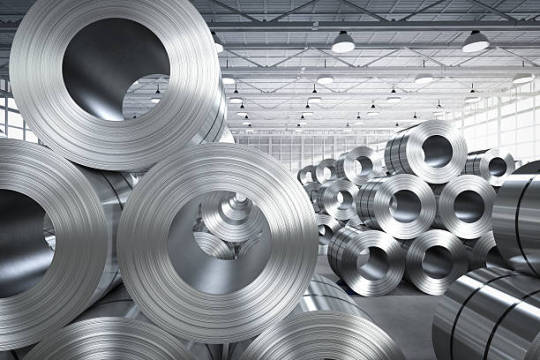
Recent Developments in Metal Recovery
Recent research has focused on refining metal recovery processes to target smaller particle sizes and optimize energy consumption. Innovations include:
Advanced Screening: Using fine screening technology to recover smaller metal particles that were previously overlooked.
Chemical Leaching: Developing eco-friendly chemical solutions to extract metals without harming the environment.
Robotic Sorting Systems: Automating the sorting process with robots to increase speed and accuracy.
These advancements have not only increased the volume of metal recovered but have also improved the overall quality of extracted metals, making them suitable for reuse in various industries.
Lohaa: Redefining Metal Trading with Ferrous and Non-Ferrous Metals
In the realm of metal recovery and trading, Lohaa has emerged as a leader, offering high-quality services that connect metal producers, recyclers, and traders efficiently. Lohaa is transforming the metal trading landscape with a modern and comprehensive approach to trading ferrous metals and non-ferrous metals through its user-friendly metal trading app.
Lohaa’s Quality Services
Lohaa is committed to providing exceptional metal trading solutions, making it a go-to platform for businesses in the metal industry. Their offerings include:
Extensive Range of Metals: Lohaa provides access to a wide variety of metals, including aluminum, zinc, lead, copper, steel, iron ore, and metal alloys. This comprehensive selection ensures that clients can easily find and trade the metals they need.
Innovative Trading Platform: With the Lohaa metal trading app, users can efficiently engage in metal trading activities, track market trends, and make informed decisions. The app is designed to simplify the trading experience, making it accessible and efficient for industry professionals.
Expertise in Ferrous and Non-Ferrous Metals: Lohaa specializes in both ferrous and non-ferrous metals, ensuring top-notch quality and reliable sourcing. Their expertise in ferrous metals like steel and iron and non-ferrous metals like aluminum and copper sets them apart in the industry.
The Future of Metal Recovery and Trading
As metal recovery technology advances, companies like Lohaa play a crucial role in the circular economy, ensuring that recovered metals are efficiently traded and reused. The integration of cutting-edge technologies in both metal recovery and trading enhances the sustainability of the metal industry, minimizing waste and maximizing resource efficiency.
Lohaa’s dedication to redefining metal trading through quality services and innovative solutions has established it as a prominent name in the sector. Whether dealing with ferrous metals, non-ferrous metals, or metal alloys, Lohaa continues to empower businesses with streamlined, reliable, and modern trading experiences.
For those engaged in the metal industry, Lohaa is not just a trading platform but a strategic partner committed to enhancing the value and accessibility of metals worldwide. As metal recovery processes continue to evolve, Lohaa remains at the forefront, bridging the gap between advanced recovery technologies and efficient market access.
1 note
·
View note
Text
Buzzer Market Size & Share Analysis - Growth Trends By Forecast Period
Buzzer Market Research
According to Straits Research, the global Buzzer Market size was valued at USD 684.28 million in 2023. It is projected to reach from USD 722.60 million in 2024 to USD 1,117.40 million by 2032, growing at a CAGR of 5.6% during the forecast period (2024–2032).

The Buzzer market, an evolving segment in the industry, is witnessing substantial expansion fueled by avant-garde technologies and escalating consumer demand. Market analysts scrupulously gather data through polls, focus groups, and in-depth scrutiny of industry patterns. These analysts utilize both quantitative and qualitative methodologies to ensure a comprehensive and precise market report. The report encompasses intricate insights on market size, growth prospects, competitive milieu, and consumer predilections. By harnessing advanced analytical instruments and expert acumen, the report delivers invaluable recommendations and strategic guidance for stakeholders, empowering them to make enlightened decisions and seize emerging prospects within the Buzzer market.
Competitive Players
The competitive landscape of the Buzzer market includes several key players who have a significant impact on market dynamics. Major companies operating in this market include:
Murata Manufacturing
TDK Corporation
Kingstate Electronics
DB Products
PUI Audio
CUI Inc., Ltd.
Huntson Electronics
Ariose Electronics
Hitpoint
Mallory Sonalert Products
Get a free sample of the Buzzer Market @ https://straitsresearch.com/report/buzzer-market/request-sample
Buzzer Market Segmentation
The comprehensive Buzzer market analysis has been divided into categories such as category, application, and delivery mode, with each subset examined according to geographical segmentation. This research will keep marketers updated and assist in pinpointing target demographics for a product or service, including insights into market share.
By Type
Piezo Buzzers
Magnetic Buzzers
By Applications
Automotive Electronics
Home Appliances
Consumer Goods
Industrial Electronics
Other
You can check In-depth Segmentation from here: https://straitsresearch.com/report/buzzer-market/segmentation
Regional Analysis
The Buzzer market is studied, and market size insights and trends are offered by nation, kind, form, and application, as previously said. The report's regional analysis section provides a thorough study of many regional and national industries to help players establish successful development strategies.
Buy the Full Buzzer Market Report @https://straitsresearch.com/buy-now/buzzer-market
Key Highlights
The purpose of this study is to examine the manufacturers of Buzzer, including profiles, primary business activities, news, sales and price, revenue, and market share.
It illustrates the market subdivided by type and application, with details on sales, price, revenue, market share, and growth rate broken down by type and application.
The research covers key regions by manufacturers, categories, and applications, including North America, Europe, Asia Pacific, the Middle East, and South America, with sales, revenue, and market share segmented by manufacturers, types, and applications.
It also investigates production costs, essential raw materials, and production methods.
Principal Motives Behind the Purchase:
To gain deep analyses of the industry and understand the commercial landscape of the global market.
To analyze production processes, key problems, and potential solutions to mitigate future issues.
To understand the most influential driving and restraining factors in the Buzzer industry and their global market impact.
To gain insights into the market strategies employed by the most successful firms.
To understand the market's future and potential.
About Us:
StraitsResearch.com is a leading research and intelligence organization, specializing in research, analytics, and advisory services along with providing business insights & research reports.
Contact Us:
Email: [email protected]
Address:825 3rd Avenue, New York, NY, USA, 10022
Tel: +1 6464807505, +44 203 318 2846
0 notes